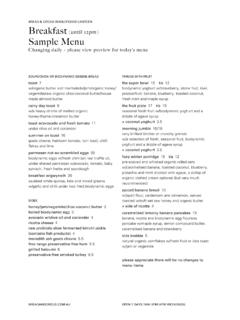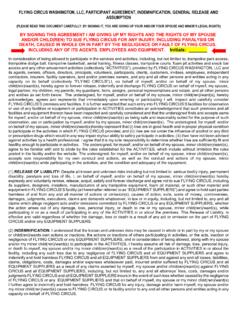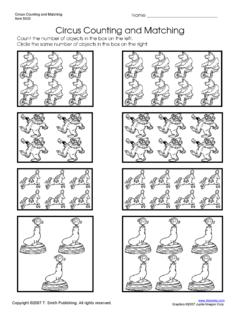Transcription of Daniel Chandler Semiotics for Beginners - The …
1 Semiotics for Beginners Daniel Chandler1 Daniel ChandlerSemiotics for BeginnersIf you go into a bookshop and ask them where to find a book on Semiotics you are likely to meet with a blank look. Even worse, you might be asked to define what Semiotics is - which would be a bit tricky if you were looking for a beginner s guide. It s worse still if you do know a bit about Semiotics , because it can be hard to offer a simple definition which is of much use in the bookshop. If you ve ever been in such a situation, you ll probably agree that it s wise not to ask.
2 Semiotics could be anywhere. The shortest definition is that it is the study of signs. But that doesn t leave enquirers much wiser. What do you mean by a sign? people usually ask next. The kinds of signs that are likely to spring immediately to mind are those which we routinely refer to as signs in everyday life, such as road signs, pub signs and star signs. If you were to agree with them that Semiotics can include the study of all these and more, people will probably assume that Semiotics is about visual signs.
3 You would confirm their hunch if you said that signs can also be drawings, paintings and photographs, and by now they d be keen to direct you to the art and photography sections. But if you are thick-skinned and tell them that it also includes words, sounds and body language they may reasonably wonder what all these things have in common and how anyone could possibly study such disparate phenomena. If you get this far they ve probably already read the signs which suggest that you are either eccentric or insane and communication may have ceased.
4 Assuming that you are not one of those annoying people who keeps everyone waiting with your awkward question, if you are searching for books on Semiotics you could do worse than by starting off in the linguistics section. It possible to conceive of a science which studies the role of signs as part of social life. It would form part of social psychology, and hence of general psychology. We shall call it semiology (from the Greek seme on, sign ). It would investigate the nature of signs and the laws governing them.
5 Since it does not yet exist, one cannot say for certain that it will exist. But it has a right to exist, a place ready for it in advance. Linguistics is only one branch of this general science. The laws which semiology will discover will be laws applicable in linguistics, and linguistics will thus be assigned to a clearly defined place in the field of human knowledge. (Saussure 1983, 15-16; Saussure 1974, 16) Thus wrote the Swiss linguist Ferdinand de Saussure (1857-1913), a founder not only of linguistics but also of what is now more usually referred to as Semiotics (in his Course in General Linguistics, 1916).
6 Other than Saussure (the usual abbreviation), key figures in the early development of Semiotics were the American philosopher Charles Sanders Peirce (sic, pronounced purse ) (1839-1914) and later Charles William Morris (1901-1979), who developed a behaviourist Semiotics . Leading modern semiotic theorists include Roland Barthes (1915-1980), Algirdas Greimas (1917-1992), Yuri Lotman (1922-1993), Christian Metz (1931-1993), Umberto Eco (b 1932) and Julia Kristeva (b 1941). A number of linguists other than Saussure have worked within a semiotic framework, such as Louis Hjelmslev (1899-1966) and Roman Jakobson (1896-1982).
7 It is difficult to disentangle European Semiotics from structuralism in its origins; major structuralists include not only Saussure but also Claude L vi-Strauss (b. 1908) in anthropology (who saw his subject as a branch of Semiotics ) and Jacques Lacan (1901-1981) in psychoanalysis. Structuralism is an analytical method which has been employed by many semioticians and which is based on Saussure s linguistic model. IntroductionSemiotics for Beginners Daniel Chandler2 Structuralists seek to describe the overall organization of sign systems as languages - as with L vi-Strauss and myth, kinship rules and totemism, Lacan and the unconscious and Barthes and Greimas and the grammar of narrative.
8 They engage in a search for deep structures underlying the surface features of phenomena. However, contemporary social Semiotics has moved beyond the structuralist concern with the internal relations of parts within a self-contained system, seeking to explore the use of signs in specific social situations. Modern semiotic theory is also sometimes allied with a Marxist approach which stresses the role of ideology. Semiotics began to become a major approach to cultural studies in the late 1960s, partly as a result of the work of Roland Barthes.
9 The translation into English of his popular essays in a collection entitled Mythologies (Barthes 1957), followed in the 1970s and 1980s by many of his other writings, greatly increased scholarly awareness of this approach. Writing in 1964, Barthes declared that semiology aims to take in any system of signs, whatever their substance and limits; images, gestures, musical sounds, objects, and the complex associations of all of these, which form the content of ritual, convention or public entertainment: these constitute, if not languages, at least systems of signification (Barthes 1967, 9).
10 The adoption of Semiotics in Britain was influenced by its prominence in the work of the Centre for Contemporary Cultural Studies (CCCS) at the University of Birmingham whilst the centre was under the direction of the neo-Marxist sociologist Stuart Hall (director 1969- 79). Although Semiotics may be less central now within cultural and media studies (at least in its earlier, more structuralist form), it remains essential for anyone in the field to understand it. What individual scholars have to assess, of course, is whether and how Semiotics may be useful in shedding light on any aspect of their concerns.






